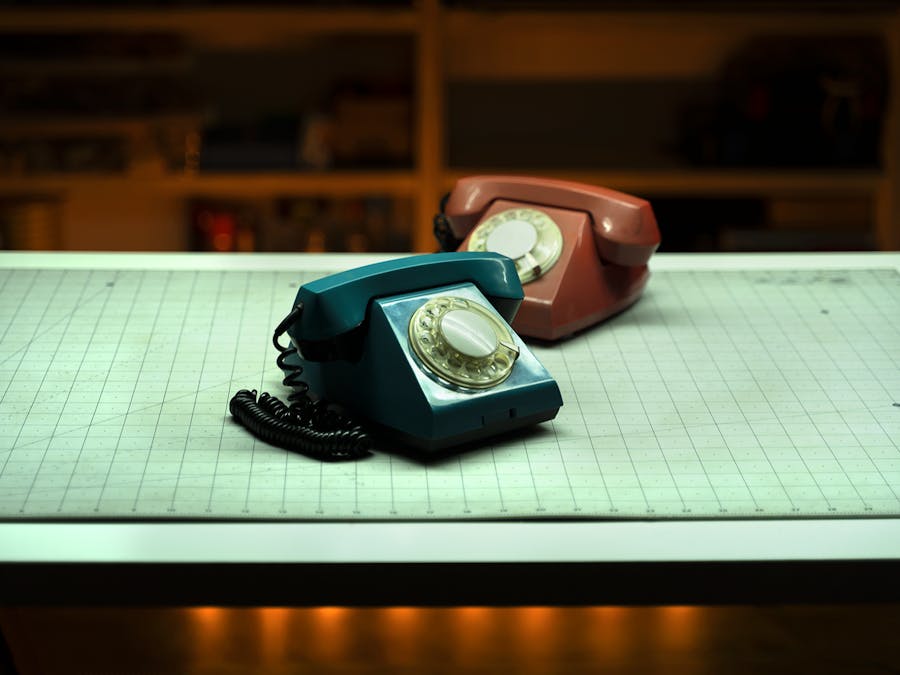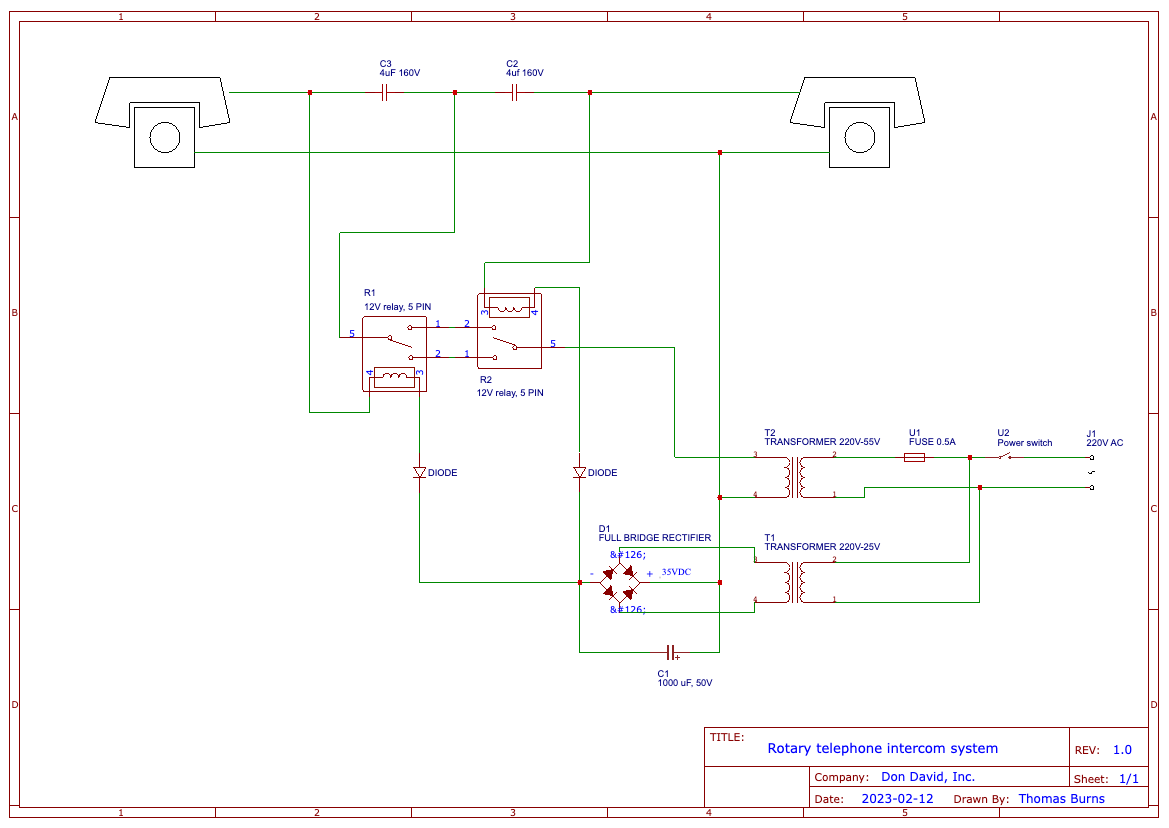I needed an intercom system for our family's computer repair business. We restore a lot of vintage tech at our shop, so I decided to make this system using two Soviet-made rotary telephones from the 1980s. Modifying a pair of these phones so that you can speak and listen is relatively simple: it basically only requires around 15V of direct current, plus a resistor. But getting the phones to ring is a bit more complicated, because the ring circuit requires alternating current. So how can we use both AC and DC to control these phones? Staying true to the analog nature of these devices, I decided to build an analog circuit to solve this problem: no transistors or microcontrollers, just some good old-fashioned transformers, relays, and capacitors!
The PhonesFor this project I used two Soviet-era telephones: a Czech-made "Tesla" model and a Latvian-made TA-68. Both of these were manufactured in the 1980s and were two of the most widely-used phones in the USSR.
I initially wanted to use two identical TA-68 phones for this project, but one of the phones wouldn't work properly with our circuit. The phone itself seemed to be functional, but after a bit of investigating I noticed that the phone's resistance (impedance?) was much, much higher than that of the other phone. I measured this with my multimeter by taking a resistance reading between the two wires in the phone's cable. The problem phone measured approximately 1 MΩ, whereas the other unit measured only 1 kΩ.
I tested all the phones that I had at the workshop until I found two with similar resistance. This is something that that needs to be checked before you start this build!
Powering the CircuitI designed this circuit based on some old schematics that have been floating around Russian-speaking electronics circles for decades. The concept is this: when one of the receivers is lifted, the circuit sends alternating current to the other phone, causing it to ring. When both receivers are lifted, the circuit sends direct current instead, which allows the users to speak and listen.
The circuit uses two transformers (or one transformer with two secondary windings) to reduce 220V mains voltage down to the levels needed for the project. For the speaking/listening part of the circuit we enough AC voltage that we can rectify into around 20-40V DC. The ringer, however, runs on alternating current. But how do we know how much AC voltage we need? Most rotary phone ringers in the US require around 50V to operate. I live outside the US and I don't have very good information about the telephone system in the USSR, so I used a variable transformer that I restored in a previous project to find the exact voltage needed to activate the phone's ringer. I did this by attaching the Variac's outputs directly to the ringer's coil inside the phone. Starting at around 60V (with the phone ringing), I slowly dialed down the voltage level until the ringer stopped. This told us that the minimum voltage needed to operate the phone's ringer was around 53V.
The most difficult part of this build was finding the right transformers. I live in Tbilisi, Georgia, and ordering parts from places like Digikey or Mouser typically takes two or three weeks for delivery. So I decided to shop locally and spent many a weekend wandering through the labyrinth of the Eliava outdoor market. Eventually, after much searching, I managed to find two transformers that would work for this build.
One transformer puts out about 55V (from 220V), which is acceptable for our ringer circuit. The second transformer I found puts out 24V, which is perfect for the speaking/listening part of the circuit. It's worth mentioning here that if you decide to use only one transformer, it must have two secondary windings, not one winding with two outputs. A center-tapped transformer with two different outputs will not work for this project.
If I could do it again, I would have taken the time to order two smaller transformers, as this would have significantly reduced the size and weight of the build. But as we so often do with electronics projects, I made do with what I had available.
One more note about the AC supply for this project: I had read that the AC voltage used to power the ringer on phones like this is usually at a lower frequency (20Hz?) than the frequency of mains voltage (50Hz where I live). Changing the frequency of alternating current sounded like a complicated job, so I chose to ignore this and push ahead. In the end, the ringer worked fine at 50Hz.
What I learned about converting AC to DC voltageI used a full bridge rectifier to convert the AC to DC for the speaking/listening part of the circuit. But after putting it all together, I was surprised to see that the DC voltage coming out of the bridge rectifier was actually higher than the AC voltage going into it. How was this possible? After some research I learned that this is completely normal: most multimeters give you the RMS value of the AC voltage sine wave, not the peak voltage, which is higher.
The DC voltage, when attached to a large filter capacitor and no load, will be roughly the value of the peak AC minus a small voltage drop from the diodes. So it's not hard to see why my DC output was higher than the RMS value of the AC input. Once a load is applied to the circuit, however, these voltage levels will change.
I built the control circuit on two 47x72mm perfboards, which I stacked using M2 nylon spacers. The circuit called for two 4uF 160V capacitors, but because I didn't have any 4uF capacitors in my kit, I substituted each of these with four 1uF capacitors wired in parallel. The two relays I used were 12V relays.
I used wire crimping ferrules for wiring whenever possible. If you aren't already using ferrules for your projects, these will completely change your game: no more loose connections or orphan strands of wire. A 22AWG ferrule will usually fit in perfboard screw terminals with a bit of persuasion, though I recently ordered even smaller, 26AWG ferrules that fit much better.
When testing your new board with the transformers, be sure you put a fuse somewhere on the power input side of the circuit. I used a 2A inline fuse wired to the primary side of the transformers. If you don't have a fuse in place and something isn't wired correctly, the result could damage the transformers, or worse. Don't rely on your power strip for protection against a short circuit.
Whenever possible, I prefer to repurpose the cases of vintage electronics for my project enclosures rather than buy new ones, mostly because the plastic options on Amazon and eBay are just so boring and soulless. For this project I used a Soviet-made electrical switching box that appears to have been used, many decades ago, for residential power distribution. I added some rubber feet, a small 3A power switch, a fuse holder, a 220V neon indicator light, and a power cord with strain relief.
The enclosure I chose is made of 1mm steel, which proved a bit difficult to work with. If you plan on drilling holes to mount components, I absolutely recommend you invest in a step drill bit and a decent set of hand files before you begin. They are inexpensive and will save you many headaches, especially if you're working with metal.
To connect the phones I used female DC barrel connectors with screw terminals for the phone cables, and male DC panel mount sockets on the face of the enclosure. In the beginning I couldn't understand why the circuit wasn't working. But I eventually realized that because the female connectors were metal, their respective grounds were effectively shorted together. This prevented the circuit from functioning normally. The solution was to replace the metal sockets with plastic versions that don't allow electrical contact with the chassis, thereby ensuring there would be no continuity between the connectors. So the lesson here is that if you are working with a metal enclosure, be sure to use connectors with plastic exteriors for this project.
In retrospect I regret not putting more time and effort into finding smaller transformers, because this would have allowed the enclosure to be much lighter. As it stands now, the final enclosure is quite heavy.
I also wish I had used a a standard C14 male socket assembly with a built-in fuse and switch for the main power connection, instead of hard-wiring power a cable to the device as I did. Having a cable permanently affixed to the enclosure makes it much more cumbersome to transport and store, and it leaves zero flexibility for varying the cable length. And having the fuse and switch all in one component would have made for a simpler and cleaner installation. Something to remember for future projects.
And lastly, I very much wanted to include several voltmeters/ammeters on the face of the enclosure to monitor operation and help with diagnostics if something wasn't working. But in the end I chose not to do this, in part due to space considerations but also because I didn't have a good way to cut small, square holes in the thick metal. I explored the possibility of using a hole saw drill bit to cut round holes for analog meters, but in the end realized that there simply wasn't enough space inside the enclosure for these meters.
After a bit of troubleshooting surrounding the phone line connections, we finally got it all up and running. The phones ring as intended, and the receivers are transmitting and receiving as we had hoped. The only thing I noticed was that the audio level was a bit low when listening and the sound is a bit crackly, but my friends who grew up in the USSR listened to it and told me this was completely normal for Soviet phones.
Many thanks for coming along on this project! Leave a comment below if you have questions or suggestions. What do you think: should we revisit this project to make these phones operate wirelessly?











Comments
Please log in or sign up to comment.